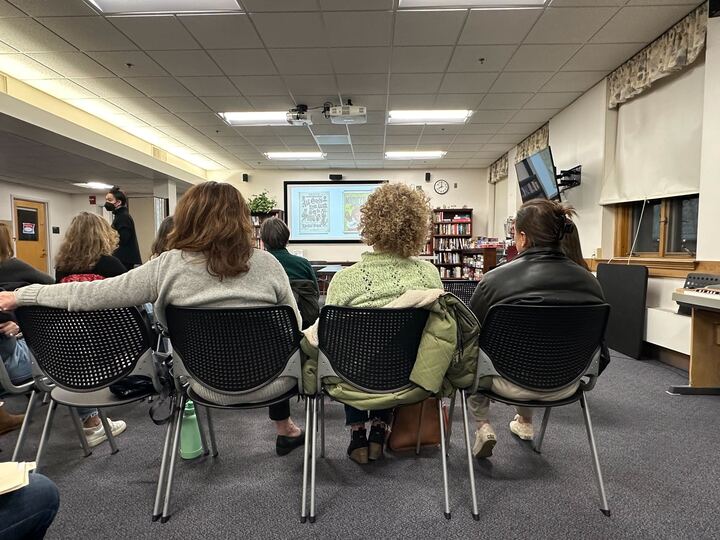
The FREEDOM PRIZE is an endowed annual award to a Wayland student(s) for the entry judged “BEST” on the topic of Freedom. The submission may be in the form of language arts (an essay, research paper, poetry, etc.), graphic arts (painting, sculpture, etc.) or performing arts (composition, music, play/drama, performance, etc.) The winner of the 2006 Freedom Prize was Zoe Leavitt for The Paradox of Freedom – Freedom of the Press During Wartime. The winner of the 2007 Freedom Prize was Olivia Blahut for Iraqi Women.
This year’s winner of the 2008 Freedom Prize is Erica Van Sciver (class of 2010) for The Torture Word.
Wayland Student Press has interviewed Erica Van Sciver and published her prize-winning essay below:
1. How did you get to choose this topic?
Since all the sophomores were permitted to write their freedom essay on a topic of their choosing, I wanted to pick something that didn’t necessarily portray our government in the best light. I think when many people associate the word “freedom” with the United States, they tend to only think of the positive connotations of that word. I was interested in shaking up that perception, and the systematic U.S. torture of military detainees seemed like a good place to start.
2. When did you first become aware of the U.S. military’s method and usage of torture?
I think I first became aware of the torture crisis about four years ago in 2004 when the Abu Ghraib pictures surfaced. It was on the front page of just about every magazine and newspaper, so the news was hard to miss.
3. Do you think preventing terrorism is the true motivation behind these tortures? If not, why do you think the U.S. military and government are so eager to detain people and torture them?
In general, I think it’s hard to say what motivates people to torture other human beings, and I’m not going to speculate. Who can say what’s going through their heads?
4. Do you think these tortures and other inhumane treatments of detainees are continued today?
Yes. About every other week I see an article in the Boston Globe on how the situation has worsened. And if dramatic action is not taken to stop the inhumane treatment, I think the solution will only continue to worsen.
5. When the government and the military have the ability to hide information so well from the public, do you think such unlawful practices will ever stop?
Regardless of any attempts by government to censor it, information is out there, one only has to look for it. However, in order for the unlawful practice of torture to end, I think it is necessary to move this issue to the forefront of our national concerns and this can only be done by raising awareness about the government’s ill treatment of the detainees.
6. What are some of the possible solutions to giving back freedom to the “invisible victims”?
Again, I think the most important thing right now is to raise more awareness about the issue. The media needs to print more coverage on this topic. The more people that are informed and aware of what’s happening, the better the chances of decisive measures being taken to end this cruel practice. In short, the plight of these “invisible victims” must be made visible in order to take the necessary steps in restoring their freedoms and human rights.
7. Which group of people in particular should step up and fight for the rights and freedom of the detainees?
Does there have to be a particular group? We are all people, as are the detainees. Their torture is a stain upon the conscience of the world.
(Wayland Veterans Memorial Freedom Prize Winning Essay)
The Torture Word
“For if this nation is to remain true to the ideals symbolized by its flag, it must not wield the tools of tyrants even to resist an assault by the forces of tyranny.” – U.S. Supreme Court Justice John Paul Stevens
Accused of launching a rocket attack on an American base, a man known solely as Dilawar was only twenty-two years old when he was brought by U.S. troops to a detention center in Bagram, Afghanistan on December 5, 2002. Only five days later he was declared dead. Initially, for months after the young Afghan taxi driver’s death, the military command in Kabul asserted that Dilawar had died of natural causes, but after tracking down Dilawar’s family in 2003, New York Times correspondent Carlotta Gall uncovered a chilling detail: on his U.S. military death certificate Dilawar’s death had been marked as a homicide. In light of this new finding, additional inquiries were launched and more horrifying facts emerged; Dilawar had been “short-shackled, arms up and feet immobile, for days on end”, beaten repeatedly by his interrogators, and his leg muscle tissue was destroyed with “repeated unlawful knee strikes so brutal that even if the victim had survived both legs would have to be amputated.” In short, Dilawar had been unmercifully and brutally tortured by his so-called “interrogators”. Yet Dilawar’s torture and resultant death was not a simple, isolated case of detainee abuse or the work of a “few bad apples”. In fact, he is only one of the countless detainees in U.S. custody who have suffered under such systematic inhumane treatment in the attempt to extract information concerning today’s ongoing war on terror. Today not only are such interrogation methods and new legislation condoning them a violation of detainees’ rights, but they are also an abuse of their freedom to be treated as human beings.
Still reeling from the aftershocks of September 11th the nation first began its slippery descent down the road to authorizing torture not six days after the terrorist attacks on the World Trade Center, when George W. Bush gave the CIA broad powers to attack terrorists, including the ability to relocate suspects to nations notorious for torture. Not long afterwards on November 13 the president issued a sweeping order allowing for the detention of Al Qaeda suspects without access to any court, instead consigning their cases to imbalanced military tribunals, and thus denying detainees their rights to due process and legal representation. But these events were only the tip of the iceberg in the Bush Administration’s new stance in fighting the war on terror: the biggest blow to human rights arrived on January 8, 2002 when the President resolved to “suspend” the Geneva Conventions, arguing that the restrictions in Common Article 3 were too vague and impractical to apply to today’s modern war on terror. In a January 25 memo to Bush justifying this course of action former Attorney General Alberto Gonzales declared that “the war against terrorism is a new kind of war…the nature of the new war places a high premium on other factors, such as the ability to quickly obtain information from captured terrorists…in my judgment this new paradigm renders obsolete Geneva’s strict limitations.” To say that the implications of this statement were enormous was an understatement. Ratified in 1949 and adhered to for more than half of a century by roughly 190 countries (including the United States), the Geneva Conventions prohibit torture, cruel treatment, and “outrages upon personal dignity, in particular, humiliating and degrading treatment.” Furthermore, the War Crimes Act of 1996 even makes it a felony to violate the Geneva Conventions. Nevertheless, overlooking these fundamental governing standards, conservative administration lawyers worked quickly to change these laws- to amend the War Crimes Act to redefine the boundaries of the freedoms safeguarded under Common Article 3 of the Conventions. This became apparent when, in a forty-two page legal memo written January 9, 2002, John Yoo of the Justice Department’s Office of Legal Counsel asserted that the Geneva Conventions and the U.S. War Crimes Act were not applicable to the Afghan War. Moreover, Yoo argued in his memo that members of Al Qaeda and the Taliban were not prisoners of war, but rather “illegal enemy combatants”, a new category which would place them outside of the protections that the conventions afforded to prisoners of war. Accordingly, not one month following this memo and other similar ones, the CIA was granted permission by the administration to practice ten “enhanced” interrogation methods on such enemy combatants, including “waterboarding”, a form of simulated drowning specifically “designed by agency psychologists.” Furthermore, a month before that former Secretary Donald Rumsfeld had approved sixteen “new” techniques in addition to the seventeen in accordance with the Geneva Conventions listed in the Army’s standard interrogation manual. Referencing one of the “approved” techniques, that of the use of stress positions (like standing); Rumsfeld appended to his authorization a jocular note adding, “However, I stand for 8-10 hours a day. Why is standing [of the detainees] limited to 4 hours?” In sum, these new developments have made clear that by changing the label of the people involved in the Afghan conflict, administration lawyers were effectively changing elemental policies on how they should be treated. Overall, Cofer Black, the former Director of the CIA’s Counterterrorist Center, summarized the government’s new stance on torture when he told Congress that “all you need to know” about “very highly classified …operational flexibility is that there was a ‘before 9/11’ and there was an ‘after 9/11’. After 9/11 the gloves came off.” And with this ominous assertion as a harbinger of things to come, it became all too apparent that when it came to taking more “flexible” measures towards detainee interrogation the CIA was no longer afraid to get its hands dirty.
Following the rapid-fire series of clandestine memos produced by the Justice Department, it was only a matter of time before torture began being implemented at numerous U.S. military prisons, perhaps most notably at that of Abu Ghraib. While reports of Iraqi prisoner abuse by U.S. soldiers began surfacing as early as October and December of 2003, it was not until April 28, 2004 that pictures documenting the abuse perpetrated at the Abu Ghraib prison emerged, and subsequently garnered an intense public outcry and international media attention on the subject of torture. For the first time, the horrific photographs of the Abu Ghraib scandal–which depicted soldiers leering at naked Iraqi detainees forced to assume a number of humiliating sexual poses– corroborated without a doubt previously unconfirmed suspicions that the U.S. military was torturing detainees. After the shocking pictures were made public, even more gruesome details of the abuses became known; a report by one official revealed that coercion methods used on detainees included the “breaking of chemical lights and pouring the phosphoric liquid on detainees, using military working dogs to frighten and intimidate detainees, beating detainees with a broom handle and a chair, threatening male detainees with rape” and a sequence of numerous other techniques, all designed to compel the prisoners into providing the army with information. According to one detainee’s account of the torture at Abu Ghraib, his captors took “photographs as if it was a porn movie. They treated us like animals, not humans…no one showed us mercy. Nothing but cursing and beating.” Although intolerable for anyone of any culture, being subjected to this treatment is particularly excruciating for Muslims, who comprising the majority of the prison population at Abu Ghraib, predominantly believe that homosexuality is unnatural, that is shameful to be naked in front of other men. For the U.S. soldiers to use the beliefs of their religion as a form of torture made the act only all that more cruel and reprehensible.
Yet perhaps most shocking of all about the Abu Ghraib scandal was the response of the White House, for although delivering formal apologies in the wake of the scandal, Bush Administration officials continued to insist that the events at Abu Ghraib did not involve systematic torture. This was illustrated on May 4, 2004 when Donald Rumsfeld asserted at a Pentagon press conference that “what has been charged thus far is abuse, which I believe is technically different from torture.” And upon being urged to provide more information he stated, “I’m not going to address the ‘torture’ word.” Yet unlike most big-news scandals, public outrage over the proceedings at Abu Ghraib did not just blow over; rather, in the coming weeks and months it intensified as more and more attention was drawn to the issue. And despite the administration’s assurances to the world that the suffering inflicted at Abu Ghraib was the work of a few bad apples, substantial amounts of evidence revealed that officials up and down the chain of command had condoned the brutality. Along these lines, as world-wide condemnation and the news coverage on the issue mounted, White House officials became increasingly more pressured to produce legislation that would prevent a scandal such as that of Abu Ghraib from ever transpiring again. Thus, the President signed into law the Detainee Treatment Act of 2005 on December 30, 2005, a law that for all intents and purposes appeared to protect and clearly establish the rights of detainees, but in actuality was ridden with loopholes that would in fact allow the torture and abuse to continue. For example, one such legalistic provision of the Detainee Treatment Act (D.T.A.) was that although the act established the U.S. Army Field Manual on Intelligence Interrogation as the governing criterion on approved interrogation techniques, it did not prevent the possibility of changes from being made to the interrogation manual. Consequently, this indicates that the approved standards for interrogation can be lowered to the point in which interrogation methods tantamount to torture would be permitted. Yet another limitation of the D.T.A. was that within it there is no precise definition for cruel, inhumane, or degrading treatment. By failing to fully define what torture is, this law has left it open for interpretation, which in turn allows the possibility that those guilty of committing such an offense will not be brought to justice for their crimes. But all these limitations pale in comparison to the specification that renders any beneficial clauses to detainees utterly irrelevant: the assertion of the Executive power as a superseding power. In short, this consideration would grant the president “complete discretion and authority over the conduct of war”, and hence the ability to exercise his authority as Commander in Chief to continue the torture of detainees in the war on terror. On the whole, rather than being the basis for a turning point in U.S. treatment of detainees, the Detainee Treatment Act legislation serves only to showcase the dramatic steps backward America has taken from its former reputation of being a country that championed the cause of human freedoms in its refusal to condone or practice torture.
Now, in the aftermath of 9/11, proponents of torture repeatedly cite the terrorist attacks on that day as having caused the deaths of nearly 3,000 Americans, a death toll that surpasses that of Pearl Harbor in 1941. They mention over and over again that more than 6,291 people were wounded- a figure that does not even begin to include those still emotionally crippled by the horrifying turn of events that September. And they argue that tough measures on intelligence-gathering must be deployed in order to prevent such an atrocity from ever occurring again. But in citing these statistics advocates for torture fail to take into consideration the people that have perhaps been most affected by the disaster of 9/11: the countless number of detainees being imprisoned and tortured in such locales as Guantanamo Bay, Abu Ghraib, and Bagram. Post 9/11, the casualties for these people comprise some 14,000 Iraqi “security detainees, [that] have been exposed to harsh interrogation, in which torture was frequently involved; over 1,100 “high value” prisoners interrogated with systematic torture, at Gauntánamo Bay and Bagram; 150 extraordinary, extralegal renditions of terror suspects to countries with a reputation for cruel and inhumane “interrogation” methods; 68 detainees dead under suspicious circumstances; some 36 high profile Al Qaeda detainees subjected to years of continual CIA torture; and 26 detainees murdered under questioning, at least 4 of them by the CIA.” In January 2003 at his State of the Union address President Bush even alluded to torture and extrajudicial execution when he spoke of “3,000 suspected terrorists…arrested in many countries. And many others have met a different fate. They are no longer a problem for the United States.”
Overall, these are the invisible victims of today’s war on terror, and their number grows every day. A common misconception remains that since the outbreak of the scandal of Abu Ghraib and the ensuing widespread public outrage, conditions for detainees have improved and that the army has regressed back to using interrogation techniques in accordance with the Geneva Conventions. However, this is a belief that couldn’t be further from the truth. According to Tina M. Foster, a New York human rights lawyer, “the problem…hasn’t gone away. The government has just done a better job of keeping it secret.” This was demonstrated all too recently on March 8, 2008 when President Bush vetoed a bill that would strictly limit CIA interrogators to using only the 19 methods listed in the Army Field Manual while banning the use of “questionable” techniques such as waterboarding and sensory deprivation. According to Bush, the reason for the veto was that the “bill Congress sent me would take away one of the most valuable tools in the war on terror.” In an all but explicit reference to the government’s sanctioning of torture on detainees, this statement serves to show how large a problem the issue of torture has become; a parasitic weed that will only continue to grow unless action is taken to wrench out the injustice by its roots.
Above all, contrary to Bush’s statements, there is nothing vague about the restrictions listed in the Geneva Conventions. In no uncertain terms, they explicitly forbid torture of any variety, regardless of the reason. Thus, the only discernible motive for the Bush Administration’s objections to abiding by the Geneva Conventions is so that U.S interrogators can continue the long list of abuses they have perpetrated. By declaring the Geneva Conventions “obsolete” Washington D.C is not saving American lives, as it claims is its objective, but endangering them. In doing so, Bush essentially gives the green light for other nations to torture Americans captured abroad, and single-handedly provides them with an excuse to rationalize their actions. After all, if America, one of the largest democratic countries in the world, can violate the Geneva Conventions, what is there to stop less scrupulous nations from doing so as well? However, not only is torture illegal under domestic and international law, but history has proved time and time again that torture is a technique that is unreliable and does not work; whereas many time-honored methods in compliance with the Geneva Conventions, such as building a rapport, are decidedly effective.
Alternative set of procedures. Waterboarding. Extraordinary rendition. Stress positions. In the legal world “torture” is a word that has many synonyms and euphemisms. Yet the difference in terminology is a distinction which allows the abuse to be perpetuated and even legalized. Nonetheless, no matter what one may call it, torture is torture and the nature of its inhumanity and cruelty is unparalleled. For centuries the United States has prided itself on being a defender of freedom and human rights, but in torturing detainees we become no better than those we condemn. In essence, by abusing and instilling fear in its captured prisoners America is utilizing the same methods as the terrorists it seeks to eradicate and inviting nations to do the same with our citizens. As a country, the United States must address the reality of its torture crisis and make the necessary motions to reverse it. Only then can we embrace the true values of our nation.











![WSPN’s Annika Martins and Maddie Zajac explore the athletic life of senior Annabelle Zhang through her badminton career. “This [photo] is me and my former partner after we won the 2022 junior nationals mixed doubles category,” Zhang said.](https://waylandstudentpress.com/wp-content/uploads/2024/04/IMG_6629-1200x900.jpg)



































































![Seniors Garrett Batt, Tom White, Emmanuel Nzaramba and Jack Calverley work together in preparation for the Spring Fling. “We decided to host this because March is kind of a slow month [in which] there’s not really that much happening, so I just thought it would be fun to put pep back into everyone so people could look forward to something this month,” senior Delcie Peter said.](https://waylandstudentpress.com/wp-content/uploads/2024/03/Screenshot-2024-03-20-at-10.28.14-PM-1200x832.png)

danielle • May 27, 2008 at 1:09 PM
Erica, this is great! Meg says hi!